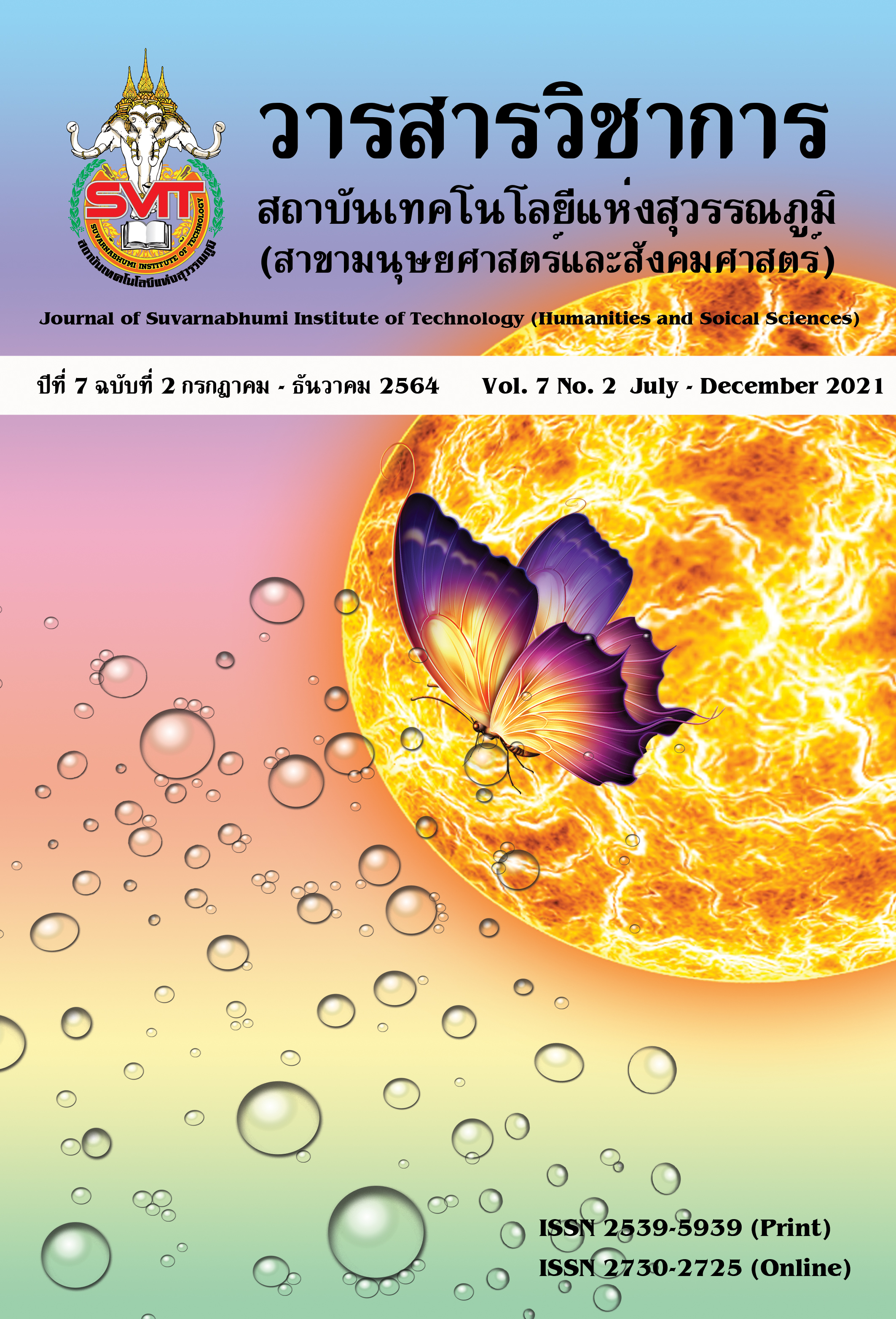DEVELOPING OF AN HAPPINESS WORKPLACE SCALE FOR WORKERS BASED ON ITEM RESPONSE MODEL: COMPUTERIZED ADAPTIVE TESTING
Keywords:
: Happiness Workplace Scale for Workers Based, Computerized Adaptive Testing, Item Response ModelAbstract
The research aimed to develop a set of computerized-standard scale for measuring happiness in working age and to examine relationships between approximate workplace happiness levels with all the items from the computerized adative testing. There are three processes invloved in this research, 1) develop a set of happiness items, examine the content validity, analyzed each items property and examine construct validity. The sample was Thai nationality that has at least 1-year working Experience, aged over 20 years old, currently work for either private or government organiztion. 2) Develop a computerized adaptive testing version of a happy workplace scale and a mobile appication. 3) Examine the correlation between happiness in workplace level ascertained from the computerized adaptive version and all the items. Pearson’s correlation coefficeint was analyed.
The research results indicated that
- The item bank of the happiness workplace scale included 43 items. They were classified into 2 factors; 19 items of motivational factors, and 24 items of maintenance factors. All items were passed the criteria by experts content validity and were anzlyzed by the Item Response Theory. Total validity of the bank was 0.97.
- The scale with 43 items, based computerized items reponse, prsented ih the form of web application was highly sitable for using.
- The correlation coefficients between the computerized adaptive scale and the result form of the all items equaled 0.89 showing a positive relationship.
References
ชูฤทธิ์ เต็งไตรสรณ์, พระครรชิต คุณวโร, และอรุณี วชิราพรทิพย์. (2551). การพัฒนามาตรวัดสุขภาวะองค์รวมแนวพุทธ. วารสารวิชาการสาธารณสุข, 17(6), 1650-1660.
ประเวช ตันติวิพัฒนสกุล, และเอกอนงค์ สีตลาภินันท์. (2554). คู่มือสร้างสุขระดับจังหวัด (พิมพ์ ครั้งที่ 2). กรุงเทพฯ: โรงพิมพ์สหกรณ์การเกษตรแห่งประเทศไทย จำกัด.
ศิรินันท์ กิตติสุขสถิต, กาญจณา ตั้งชลทิพย์, สุภรต์ จรัสสิทธิ์, เฉลิมพล สายประเสริฐ, พอตา บุนยตีรณะ และวรรณภา อารีย์. (2555). คู่มือการวัดความสุขด้วยตนเอง HAPPINOMETER (พิมพ์ครั้งที่ 1). นครปฐม: สถาบันวิจัยประชากรและสังคม มหาวิทยาลัยมหิดล.
สำนักงานสถิติพยากรณ์. (2558). การสำรวจสุขภาพจิต(ความสุข)คนไทย พ.ศ. 2558. สืบค้น 3 มีนาคม 2560, จากhttp://www.nso.go.th/nso/nsopublish/themes/files/mental-healthm_FullReport_ 58.pdf
อรยา ปรีชาพานิช. (2557). คู่มือเรียน การวิเคราะห์และออกแบบระบบ (System Analysis and Design) (ฉบับสมบูรณ์). นนทบุรี: ไอดีซี พรีเมียร์.
Anand, P. (2016). Happiness Explained. Oxford University Press.
Embetson, S.E., & Reise, S. P. (2000). Item response theory for psychologist. Mahwah, NJ: Lawrence Erlbaum.
Fliege, H., Becker, J., Walter, O. B., Bjorner, J. B., Klapp, B. F., & Rose, M. (2005). Development of a computer-adaptive test for depression (D-CAT). Quality of life Research, 14(10), 2277-2291.
Gibbons, R. D., Weiss, D.J., Kupfer, D.J., Frank, E., Fagiolini, A. Grochocinski, V. J., Bhaumik, D. K., Stover, A., Bock, R. D., & Immekus, J. C. (2008). Using Computerized Adaptive Testing to Reduce the Burden of Mental Health Assessment. Psychiatric Services, 59(4), 361-368.
Herzberg, F. (2005). Motivation-hygiene theory. Organizational behavior one: Essential theories of motivation and leadership, eds JB Miner, ME Sharpe Inc, New York, 61-74.
Kocalevent, R. D., Rose, M., Becker, J., Walter, O. B., Fliege, H., Bjorner, J. B., & Klapp, B. F. (2009). An evaluation of patient-reported outcomes found computerized adaptive testing was efficient in assessing stress perception. Journal of Clinical Epidemiology, 62(3), 278-287.
Simms, L. J., Goldberg, L. R., Roberts, J. E., Watson, D., Welte, J., & Rotterman, J. H. (2011). Computerized Adaptive Assessment of personality Disorder: Introducing the CAT-PD Project. Personality Assessment, 93(4), 380-389.
Singh, A., Juneja, D., & Malhotra, M. (2015). Autonomous Agent Based Load Balancing Algorithm in Cloud Computing. Procedia Computer Science, 45(1), 832-841.
Smith, H. C. (1985). Psychology of Industrial Behavior. New York: McGrwa-Hill Book Co.
Thomas, M. L. (2011). The Value of Item Response Theory in Clinical Assessment: A Review. Assessment, 18(3),291-307.
Downloads
Published
Issue
Section
License
บทความที่ได้รับการตีพิมพ์เป็นลิขสิทธิ์ของวารสารวิชาการ สถาบันเทคโนโลยีแห่งสุวรรณภูมิ
ข้อความที่ปรากฏในบทความแต่ละเรื่องในวารสารวิชาการเล่มนี้เป็นความคิดเห็นส่วนตัวของผู้เขียนแต่ละท่านไม่เกี่ยวข้องกับสถาบันเทคโนโลยีแห่งสุวรรณภูมิ และคณาจารย์ท่านอื่นๆในสถาบันฯ แต่อย่างใด ความรับผิดชอบองค์ประกอบทั้งหมดของบทความแต่ละเรื่องเป็นของผู้เขียนแต่ละท่าน หากมีความผิดพลาดใดๆ ผู้เขียนแต่ละท่านจะรับผิดชอบบทความของตนเองแต่ผู้เดียว





